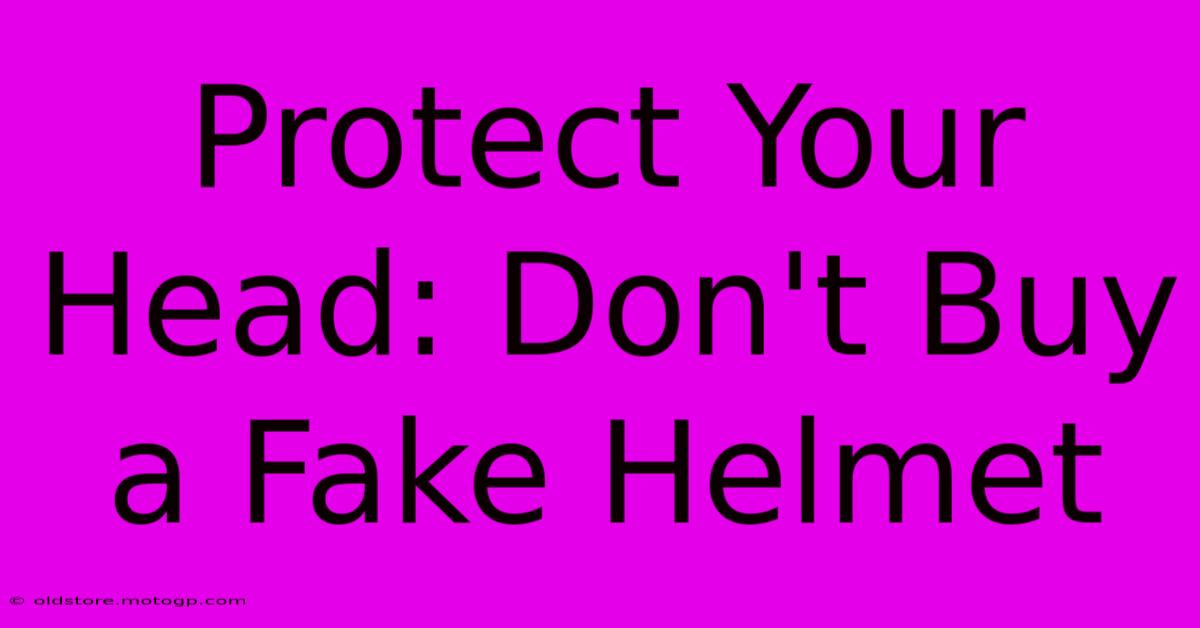Protect Your Head: Don't Buy A Fake Helmet

Table of Contents
Protect Your Head: Don't Buy a Fake Helmet
Your helmet is your first line of defense against serious head injuries. It's the crucial piece of safety equipment that stands between you and potential lifelong consequences. But what happens when that helmet isn't what it seems? Buying a fake helmet isn't just a waste of money; it's a gamble with your life. This article will explain why purchasing authentic, certified helmets is paramount to your safety and what to look out for when making your purchase.
The Dangers of Counterfeit Helmets
Counterfeit helmets are often produced with substandard materials and lack the rigorous testing and certification required of genuine safety equipment. This means they may:
- Fail to provide adequate protection: In a crash, a fake helmet may shatter, crack, or deform far more easily than a genuine one, leaving you vulnerable to severe head trauma. This could lead to concussions, brain damage, or even death.
- Offer insufficient impact absorption: Properly engineered helmets use specialized materials to absorb the impact of a collision. Fake helmets often lack these features, resulting in the full force of the impact transferring directly to your head.
- Compromise structural integrity: The shell, liner, and straps of a genuine helmet are designed to work together as a system. Counterfeit helmets may lack this critical integration, increasing the risk of injury.
- Have unreliable retention systems: A poorly designed or manufactured chin strap or other retention system can lead to the helmet coming off during an impact, leaving your head unprotected.
Identifying a Fake Helmet: Spotting the Red Flags
Knowing how to identify a fake helmet can save your life. Here are some key indicators to watch out for:
1. Price:
If a helmet is significantly cheaper than comparable models from reputable brands, it's a major red flag. Legitimate manufacturers invest heavily in research, development, testing, and materials. An abnormally low price likely indicates a counterfeit product.
2. Packaging and Labeling:
Examine the packaging carefully. Look for poor printing quality, spelling errors, or inconsistencies in branding. Authentic helmets usually come with clear and detailed labeling, including safety certifications. Check for the presence of relevant certification marks, such as DOT (Department of Transportation) in the US or ECE (Economic Commission for Europe) in Europe. Absence of these markings or poorly reproduced markings should raise serious concerns.
3. Materials and Construction:
Feel the helmet's shell and liner. Counterfeit helmets often feel cheap and flimsy. Look for uneven stitching, poorly finished seams, or loose components. The overall quality of materials and craftsmanship should be consistent with the brand's reputation.
4. Safety Certification Stickers:
These stickers aren't just decals; they’re proof the helmet has undergone rigorous testing. If the sticker looks poorly printed or doesn't match the helmet's other markings, be wary. Consider carefully examining the sticker for any inconsistencies or signs of tampering.
5. Source of Purchase:
Where did you buy the helmet? Purchasing from unauthorized sellers, especially online marketplaces with lax verification processes, significantly increases the risk of buying a fake. Buy from authorized retailers or directly from reputable brands.
Protecting Yourself: Buying Smart
To ensure your safety, always:
- Buy from authorized retailers: Check the manufacturer's website for a list of authorized dealers in your area.
- Verify safety certifications: Look for relevant safety standards markings (DOT, ECE, Snell, etc.).
- Read reviews: See what other customers say about the helmet and the seller.
- Don't sacrifice safety for price: A helmet is an investment in your well-being.
Your head is priceless. Don't let a counterfeit helmet put it at risk. Investing in a genuine, certified helmet is the best way to ensure your safety and peace of mind. It’s a small price to pay for the protection of your most valuable asset: your life.

Thank you for visiting our website wich cover about Protect Your Head: Don't Buy A Fake Helmet. We hope the information provided has been useful to you. Feel free to contact us if you have any questions or need further assistance. See you next time and dont miss to bookmark.
Featured Posts
-
F1 Understanding The Grid Formula For Better Race Analysis
Feb 19, 2025
-
Get The Latest Moto2 Standings For 2025
Feb 19, 2025
-
The Most Famous Circuit Race Drivers
Feb 19, 2025
-
Moto2 Bikes The Next Level
Feb 19, 2025
-
The Art Of Racing Moto Gp On Tnt Sports
Feb 19, 2025
